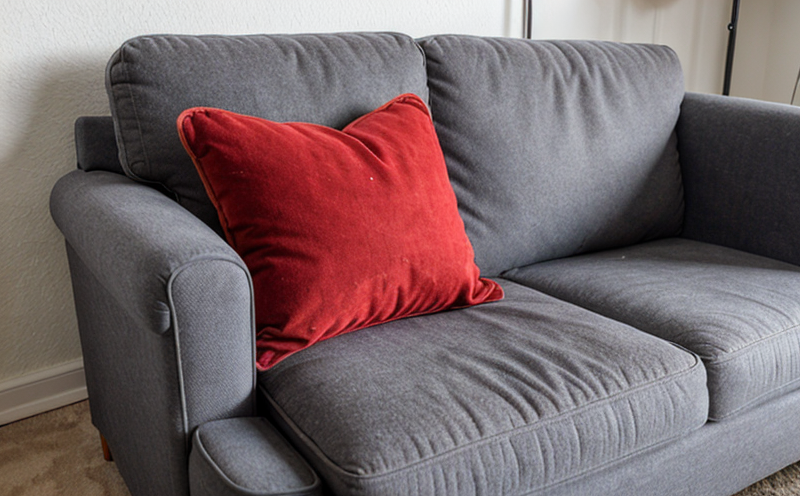ASTM D5035 Strip Method Tensile Strength Testing of Cushion Fabrics
The ASTM D5035 standard provides a comprehensive method to measure the tensile strength of cushion fabrics used in furniture upholstery. This testing is critical for ensuring that materials meet durability requirements, which are essential for providing comfort and safety while maintaining aesthetic appeal.
The test involves cutting samples from the fabric in a specific manner according to ASTM D5035 standards. The specimens are then clamped into a tensile testing machine where they undergo stress until failure occurs. The maximum force applied before failure is recorded as the tensile strength.
This test is particularly important for cushion fabrics because it helps manufacturers and quality managers ensure that materials can withstand the stresses encountered during typical use, such as sitting and moving on furniture. By adhering to ASTM D5035, companies can guarantee product reliability and compliance with industry standards.
The process begins with selecting appropriate test samples from the cushion fabric. These samples must be cut according to specified dimensions outlined in the standard. It is crucial that these cuts are precise to ensure accurate results. Once prepared, the specimens are placed into a tensile testing machine equipped with grips capable of holding the samples securely.
The testing itself involves applying controlled tension to the sample until it fails due to tearing or breaking. The machine measures this force and records the point at which failure occurs. This value represents the tensile strength of the fabric, expressed in pounds per square inch (psi).
Understanding the implications of these tests is key for those involved in furniture manufacturing and design. For instance, knowing how various fabrics perform under stress allows engineers to make informed decisions about material selection. Compliance with ASTM D5035 ensures that products meet not only internal quality control standards but also external regulatory requirements.
The results from this test play a vital role in improving product performance by identifying weaknesses within the fabric structure early on during development stages. Additionally, it helps manufacturers address potential issues before releasing products to market, thereby enhancing overall customer satisfaction and reducing warranty claims.
In summary, ASTM D5035 strip method tensile strength testing of cushion fabrics is an essential procedure for maintaining high-quality standards in furniture upholstery. It provides valuable insights into the durability characteristics of different materials used in this sector, ultimately leading to better-performing products that meet both functional and aesthetic expectations.
Why Choose This Test
Selecting ASTM D5035 strip method tensile strength testing for cushion fabrics offers several advantages over other methods. Firstly, it provides precise measurements of the fabric’s tensile properties, allowing manufacturers to identify any inconsistencies early in production processes. Secondly, this test helps ensure consistent quality across batches by providing repeatable results. Thirdly, compliance with industry standards like ASTM D5035 demonstrates a commitment to excellence and trustworthiness among consumers.
Moreover, using ASTM D5035 ensures that products meet not only internal quality control standards but also external regulatory requirements, which is increasingly important in today’s competitive market. By adhering to such rigorous testing protocols, companies can build strong reputations for reliability and innovation within their industry.
- Consistency: Ensures uniformity of material performance across all products
- Quality Assurance: Guarantees adherence to established quality benchmarks
- Regulatory Compliance: Meets necessary standards set by governing bodies
- Consumer Trust: Builds confidence among end-users regarding product integrity and longevity
- Innovation: Encourages continuous improvement through detailed analysis of material behavior under stress.
These factors make ASTM D5035 strip method tensile strength testing an indispensable tool for any company serious about maintaining top-notch standards in furniture upholstery.
Environmental and Sustainability Contributions
The pursuit of sustainable practices has become a priority across numerous industries, including furniture manufacturing. By implementing ASTM D5035 strip method tensile strength testing, manufacturers contribute positively to environmental sustainability efforts by ensuring longevity and recyclability of materials used in their products.
Materials that pass stringent tensile strength tests are more likely to last longer without breaking or tearing during use. This increased durability translates into reduced waste generation since consumers do not need frequent replacements for failed components. As a result, less raw material is required throughout the lifecycle of each product, contributing significantly towards resource conservation.
Furthermore, sustainable materials often have lower carbon footprints compared to non-sustainable alternatives due to efficient production methods or renewable sourcing practices employed by suppliers. When coupled with robust tensile strength testing like ASTM D5035, these eco-friendly options become even more attractive choices for environmentally conscious consumers who prioritize green purchasing decisions.
By adopting ASTM D5035 strip method tensile strength testing into their quality assurance protocols, furniture companies not only enhance product performance but also promote responsible business practices aligned with global sustainability goals. This dual approach fosters long-term relationships with eco-minded customers while driving innovation within the industry towards greener solutions.
Competitive Advantage and Market Impact
The implementation of ASTM D5035 strip method tensile strength testing offers significant competitive advantages that can positively influence market positioning. By conducting these tests, manufacturers gain deeper insights into their product’s durability potential, enabling them to optimize material selection based on real-world performance data.
- Enhanced Reputation: Demonstrating commitment to rigorous quality control enhances brand reputation and customer trust
- Informed Decision-Making: Precise testing results guide choices regarding fabric types and finishes for optimal performance
- Increased Efficiency: Identifying weak points early in production reduces costs associated with rework or scrap
- Better Product Lifecycle Management: Longer-lasting products lead to increased customer satisfaction and loyalty, translating into higher sales volumes
- Sustained Competitive Edge: Continuous improvement driven by thorough testing maintains a company’s position as leader in its field.
These benefits translate directly into enhanced competitiveness within the market. Companies that prioritize ASTM D5035 strip method tensile strength testing demonstrate their dedication to excellence, which can attract more discerning customers seeking reliable products. Additionally, by staying ahead of competitors through superior product quality and sustainability efforts, businesses carve out a niche for themselves in crowded markets.





